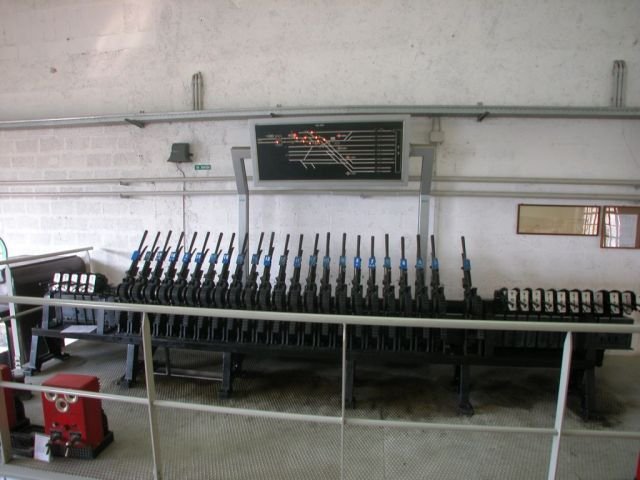MAX JUDEL INTERLOCKING LEVERS FOR RAILWAY SIGNALLING

-
Item owner - FNM
-
Category - FNM collection
-
Inventory - 1696
-
Author - Max Judel
-
Dimensions - 1.2x12x1m
-
Dating - 1895
The complex, originally assembled in Milano Cadorna station, consists essentially of:
- a backlit panel positioned at the top depicting the "layout plan" of Ferrovie Nord’s Milano Cadorna station, that is, all the tracks, points and signals controlled and manoeuvred by the mechanism;
- 3 sets of levers on the top of the bench: the first, on the left, has 5 levers with raised and lowered positions for itineraries in arrival on the 10 tracks
in the station; the second, in the middle, has 24 levers with raised and lowered positions for controlling the points; the third, on the right, has 10 levers with raised and lowered positions for departures and reverse shunting.
- below the counter, aligned with each of the levers in the central part, is a series of rigid mechanical tubular connections linked with the points at track level.
- behind the levers is a long bench on which a mechanical lock is installed, composed of a multitude of bolts and hammers made several decades after the assembly of the original bench, which was merely mechanical.
The bench serves to prepare itineraries for train arrival and departure or marshalling in the shelter-shunting area by operating the appropriate levers, with mechanical constraints to ensure that no incompatible paths are created.
The point bench is supervised by a series of highly specialised workers referred to as shunters, varying in number according to the intensity of rail traffic. The order to operate one or more levers and therefore prepare the itinerary for reception or departure of a train in or from a given track comes from the stationmaster, who follows a pre-established schedule or creates one on the spot in the event of disruptions or abnormalities. Mechanical constraints ensure that two trains moving in the station at the same time cannot travel merging itineraries and collide.
Max Judel interlocking levers were invented in the second half of the nineteenth century in Braunschweig, Germany, at a time when steadily growing rail traffic in Europe inevitably required centralisation of the operation of points and signals to maintain sufficient levels of safety. The system was completely mechanical, with a system of levers and gearboxes, both rigid through jointed tubes and on steel wire ropes with pulley returns. Signals were also operated by wire ropes, while the points may be operated by wire ropes or pipes. Pneumatic interlocking levers were installed in Varese in 1929, quite possibly the only ones of their kind in Italy. The system in question, taken from Milano Cadorna station and partially reassembled in the Museum, where it is still partly operable, was installed on 1 May 1895 (service order 15-1895), on the occasion of the renovation of the station following lowering of the track level in the trench in Via Mario Pagano, and at the time it controlled 7 tracks in the station; this entirely mechanical system was in operation for more than thirty years. Station signals were wire-controlled semaphore signals, while the points were commanded by pipes, requiring considerable physical strength in view of the great distance between the control post and the location of the most distant points (up to 200 metres), as well as the significant amount of train traffic in Milan: up to 350 trains during the station’s 19 or so hours of daily operation in the system’s final years. In 1928 the number of tracks was increased to 10, and the system was adapted accordingly.Signals and points were connected to a lock on the bench which prevented erroneous movements to prevent accidents.
The Max Judel system was particularly robust and dependable, and in fact it was used for a century in the station in Milan, until 1995. Systems with wire transmission also proved dependable (such as the one in Saronno station, which came right after Milan in the intensity of traffic, where the system remained in operation until March 2000).